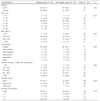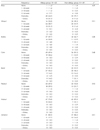Abstract
The aim of this study was to examine and compare the eating habits and dietary intake patterns of people with or without allergy by the survey during August-September, 2008. The 131 subjects aged 10'-50' (AG = allergy group, n = 62; NG = non-allergy group, n = 69) participated in this study. The questionnaire included general characteristics, dietary habits, and food frequency. Income level tended to be higher in AG than in NG, and AG had more pets and flower pots than NG (p < 0.01). In AG, most affected area of allergy was the skin and the subjects in AG experienced the mixed symptoms and more than 2 types of allergy. Family history of allergy was highly related with allergy of the subjects (AG: 66.1%, NG: 33.9%). Both groups did not exercise regularly, but frequency of alcohol drinking in AG was significantly higher than in NG (p < 0.01). AG skipped meals and had snacking more often than NG (p < 0.05). Most favorite snacks in AG were instant foods, fast foods, cookies, and ice cream (p < 0.05). Therefore, AG tended to consume more allergy-related foods than NG. Highly-consumed allergy-related foods were egg, pork, walnut, onion, tuna, shellfish, and kiwi (p < 0.05). Therefore, nutrition education and guidance is needed to establish good eating habits, food intakes, and life style in people having allergy.
Figures and Tables
References
1. Mansour Mona E., Lanphear Bruce P., DeWitt Thomas G.. Barriers to asthma care in urban children: parent perspectives. Pediatrics. 2000. 106(3):512–519.

2. May CD. Objective clinical and laboratory studies of immediate hypersensitivity reactions to foods in asthmatic children. J Allergy Clin Immunol. 1976. 58(4):500–515.

3. Han JS, Hong SO, Kim JS, Han JP, Kim NS. Frequency of food allergy in Korea and the causative food allergens. J Korean Soc Food Sci Nutr. 1997. 26(1):1–9.
4. Sloan AE, Powers ME. A perspective on popular perceptions of adverse reactions to foods. J Allergy Clin Immunol. 1986. 78(1):127–133.

6. Chandra RK, Puri S, Cheema PS. Predictive value of cord blood IgE in the development of atopic disease and role of breast-feeding in its prevention. Clin Allergy. 1985. 15(6):517–522.

7. Ministry for Health, Welfare and Family Affairs. Korea Center for Disease Control and Prevention. 2007 Korea National Health Statistics: Korea National Health and Nutrition Examination Surveys Phase IV(first year, 2007) Result Report. 2008.
8. Lee YJ, Choi SH, Han JS. A Study on the actual state of food allergy and food behavior in adults. J East Asian Soc Dietary Life. 2003. 13(3):167–175.
9. Lee KW, Myung CO, Nam HW, Hong CS, Lee YC. A study on nutritional status of allergic patients and food allergens in Korea. J Korean Dietary Culture. 1996. 11(1):123–130.
10. Confino-Cohen R, Melamed S, Goldberg A. Debilitating beliefs, emotional distress and quality of life in patients given immunotherapy for insect sting allergy. Clin Exp Allergy. 2002. 29(12):1626–1631.

11. Kim YS, Park JW, Kim GY, Song YS, Kim CW, Park JW, Hong CS. The comparison of quality of life and stress among healthy, allergy and other-diseases group, allergy and other-diseases groups. Korean J Asthma Allergy Clin Immunol. 2001. 21(4):647–656.
12. Hong SJ, Lee MS, Sohn MH, Shim JY, Han YS, Park Ks, Ahn YM, Son BK, Lee HB. Korean ISAAC Study Group. Self-reported prevalence and risk factors of asthma among Korean adolescents: 5-year follow-up study, 1995-2000. Clin Exp Allergy. 2004. 34(10):1556–1562.

14. Sampson HA. Food allergy. part 2: diagnosis and management. J Allergy Clin Immunol. 1999. 103:981–998.

15. Son DY, Yoon KR, Lee SI. Study of the most common allergic foods in Korea. J Korean Sci Food Technol. 2002. 34(5):885–888.
16. Jung JY, Son JY, Hong SJ, Lee YW, Sin YS, Park JW, Hong CS. Comparison of the patient's global self-assessment scoring method with the quality of life questionnaire for sment Korean asthmatics. Korean J Asthma Allergy Clin Immunol. 2008. 28(2):134–142.
17. Sampson HA, Mendelson L, Rosen JP. Fatal and near fatal anaphylactic reactions to food in children and adolescents. N Engl J Med. 1992. 327(6):380–384.

18. Fuglsang G, Madsen C, Halken S, Jorgensen M, Ostergaard PA, Osterballe O. Adverse reactions to food additives in children with atopic symptoms. Allergy. 2007. 49(1):31–37.

19. Warrington RJ, Patricia JS, Mcphillips S. Cell-mediated immune responses to artificial food additives in chronic urticaria. Clin Exp Allergy. 2006. 16(6):527–533.

20. Choi OB. Anti-allergic effects of petasites japonicum. J Korean Soc Food Sci Nutr. 2002. 15(4):382–385.
21. Krieger James W., Song Lin, Takaro Timothy K., Stout James. Asthma and the home environment of low-income urban children: Preliminary findings from the seattle-king county healthy homes project. J Urban Health. 2000. 77(1):50–67.

22. Caldeira RD, Bettiol H, Barbieri MA, Terra-Filho J, Garcia CA, Vianna EO. Prevalence and risk factors for work related asthma in young adults. Occup Environ Med. 2006. 63:694–699.

23. Hong SA, Lee SM, Lee MY, Jung JT. A study of the dietary intake and causative foods in allergic children. Pediatr Allergy Respir Dis(Korea). 1999. 9(1):79–92.
24. Ahn YM, Lim SH. Comparison of the skin prick test positivity of three commercial cat fur extracts and study on the possibility of contamination with house dust mites in cat fur extracts. Allergy. 1990. 10(3):235–242.
25. Ahn HS, Lee MY, Lee SM, Choung JT, Hwang EM. Growth, nutrient intake and allergic manifestations of the infants with family history of allergy fed on hypoallergenic formula vs general formula. Pediatr Allergy Respir Dis. 1997. 7(2):248–264.
26. Kim YS, Park JW, Kim GY, Song YS, Kim GY, Kim CW, Park JW, Hong CS. The comparison of lifestyle patterns between allergy and non-allergy people-food intake, exercise, smoking, alcohol intake. J Korean Community Nutr. 2001. 12(1):269–277.
27. Kim YS, Park JW, Song YS. Seasons variation of house dust mites allergen and perceived allergic symptoms. J Korea Community Health Nursing Academic Society. 2002. 16(1):30–44.
28. Kilpelanen M, Terho EO, Helenius H, Koskenvuo M. Farm environment in childhood prevents the development of allergies. Clin Exp Allergy. 2000. 30(2):201–208.

29. Jo JA, Ahn EJ, Bae CY, Shin DH. A study on family history and environmental factors of atopic diseases. J Korean Acad Fam Med. 1994. 15(8):525–534.
30. Cole JC, Own DR, Havstad SL, Perterson EL. Family history, dust mite exposure in early childhood, and risk pediatric atopy and asthma. J Allergy Clin Immunol. 2004. 114(1):105–110.
31. Min KU, Kim SH. Recommendations for the prevention of allergic diseases in Korea. Korean J Asthma Allergy Clin Immunol. 1999. 19(5):637–643.




 PDF
PDF ePub
ePub Citation
Citation Print
Print










 XML Download
XML Download